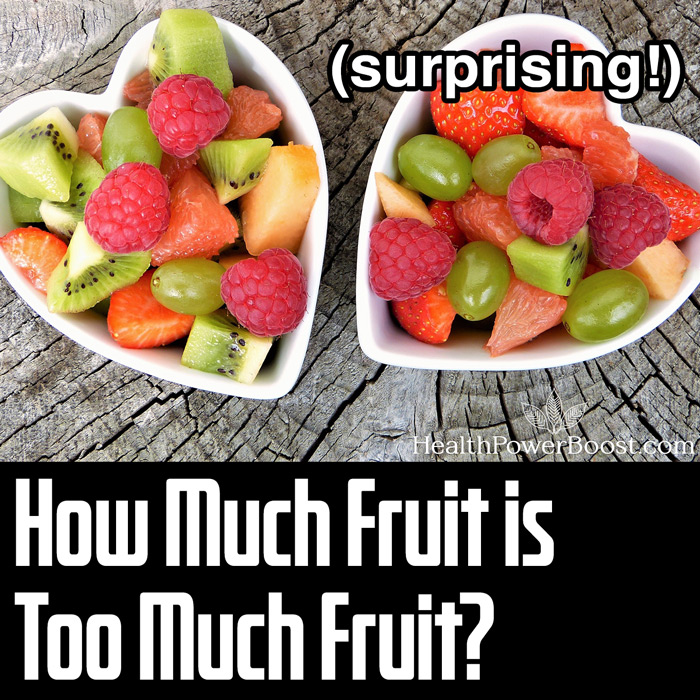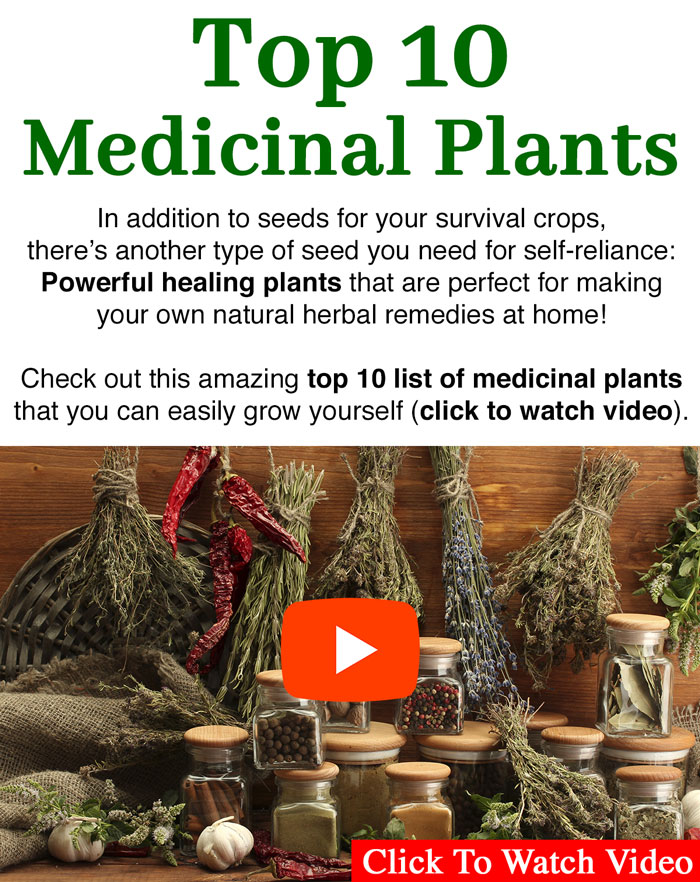This website is not medical advice. Posts may contain affiliate links from which I earn commissions at no additional cost to you.

How Much Fruit is Too Much Fruit? Graphic © healthpowerboost.com. Background photo: Pixabay (PD)
Fruit intake has long been associated with a healthy diet and healthy lifestyle choices. However, is there a healthy limit to how much fruit we can actually eat? Isn’t having too much of anything bad for you?

Dr. Michael Greger discusses how much fruit is too much fruit – in particular as it relates to blood sugar and insulin – in one video on his popular Youtube channel, Nutrition Facts. Here’s our review – the video is at the end.
Berries Found To Improve Insulin Response And Hyperglycemia
Data from the World Health Organization reports that over 422 million people have diabetes all over the world. [1] Diabetes is characterized by persistently high blood sugar, because of the body being resistant to insulin. Insulin works by stimulating our cells to absorb glucose or sugar from food. When the cells become resistant to insulin, glucose remains circulating in the blood stream, a condition called hyperglycemia. Persistently high blood sugar levels cause weight gain, poor wound healing, and in worst cases, kidney failure and blindness. [2]
The first study covered by Dr. Greger was published in 2013 by Törrönen, et. al. and reported the antioxidant effects of berries on postprandial hyperglycemia after eating bread. [3] White bread is known to cause high postprandial glucose and stimulate the insulin response. Rye bread is similar, but postprandial glucose is lower. Because previous in-vitro studies showed how the polyphenols from berries was able to reduce digestion and absorption of starch and reduce postprandial hyperglycemia, the researchers conducted a trial involving 3 randomized, controlled, crossover studies by adding 150 grams of berries with white and rye bread (with 50 grams of starch).
The results of the studies revealed that the following improved the body’s insulin response:
– Strawberries, bilberries, lingonberries, and chokeberries with white bread
– A berry mixture with strawberries, bilberries, cranberries, and blackcurrants with both white and rye bread

On the other hand, the following was able to reduce postprandial hyperglycemia:
– Strawberries, by 39%
– The berry mixture, by 38% with white bread and by 19% with rye bread
Similarly, Blacker, et. al. reported in the same year that blueberries in particular exhibited strong antioxidant properties due their phenolic content, not their fructose or ascorbate. [4] The study revealed that blueberries were able to reduce postprandial oxidation after a high-carbohydrate, low-fat breakfast. The more blueberries were included in the meal, the higher the antioxidation effects.
Diabetics And Fruit Intake
The real lowdown on fruit and hyperglycemia was seen in a study by Christensen, et. al. in 2013. The researchers focused on the effects of high dose and low dose fruit intake on the HbA1C levels of newly diagnosed type 2 diabetics; HbA1C being one the standards used in diagnosing diabetes. The study involved 63 participants with one group receiving 125 grams of fruit and the other 51 grams. After 12 weeks, both groups had reduced weight and waist circumference but there was no significant difference between groups. HbA1C levels were the same; they were reduced in both groups with no significant difference between groups. [5] The researchers concluded that fruit intake should not be restricted among type 2 diabetics.
Improving Glycemic Control With Fruits
Fructose, which is the kind of sugar found in fruits, has also been shown to actually improve glycemic control rather than be detrimental to it. In 2012, six studies were examined and revealed that small doses of fruit less than 10 grams per meal or 36 grams per day was able to improve post-prandial blood sugar levels without adverse effects on body weight or fasting insulin levels. [6] The researchers recommend further studies being done, particularly longitudinal studies that last more than 6 months to confirm their results.
This goes to show that fruits aren’t the problem; fructose only becomes harmful when it is refined and added to high-fructose corn syrup and table sugar – which in turn are added to unhealthy snacks and packaged food found in the market. Dr. Bistrian, a professor at Harvard, says that fruits are not harmful, and are beneficial in almost any amount – seen in the 2012 study by Sievenpiper. [7]

Further Benefits Of Fruit In Your Diet
Fruit (and vegetables) also have other benefits aside from improving your blood sugar control and weight loss. A diet high in fruit intake can also improve lipid levels, specifically by lowering low-density lipoprotein (LDL) levels. LDL is also called bad cholesterol because it damages the blood vessels and increases your risk for heart disease, heart attacks, and strokes. A diet that was high in fruit, vegetable and nut intake was able to reduce the risk for heart disease because of this. This very same study was also able to report major improvements in bowel movements due to the fiber content of fruits and vegetables. [8]
Dreher (2018) reports that fruits have a myriad of potential health benefits such as but not limited to [9]:
– Improved gastrointestinal health due to fruit fibers which help prevent constipation, irritable bowel syndrome, inflammatory bowel disease, and diverticular disease
– Long-term weight management
– Reduced risk for cardiovascular disease and type 2 diabetes
– Reduced risk for colorectal and lung cancers
– Reducing the severity of lung diseases
– Promoting healthy aging
– Improving psychological well-being and health and reducing the risk for depression
– Improving bone density in children and adults
In fact, Dreher warns against low fruit intake and its potential impact as a population health threat.
If you want to include more fruit in your diet (and if you’re a fan of yogurt), you can try substituting snacks with fruit and yogurt. A study in 2017 focused on the health benefits of yogurt and fruit in combination with each other and the results were very promising. The researchers reported that yogurt and fruits eaten together were able to exhibit significant prebiotic and probiotic effects. Replacing high-energy, nutrient-deficient snacks (snacks with “empty calories”) with yogurt and fruit could impact your health positively through weight loss and reduced risk for diabetes and heart disease. [10]
Top 10 Fruits Most Beneficial To Health
Which are the best fruits to eat? Here’s a list of some of the most nutritious fruits, with nutrient information:
1. Apples
Apples, renowned for their nutritional richness, are a treasure trove of health-promoting phytonutrients. They are particularly abundant in both soluble and insoluble fibers like pectin, hemicellulose, and cellulose. These fibers not only aid in managing blood sugar levels but also promote good digestion and support gut and heart health. Additionally, apples are a notable source of vitamin C and an array of plant polyphenols. These compounds play a pivotal role in disease prevention, potentially lowering the risk of heart disease, stroke, cancer, obesity, and neurological disorders. The presence of these polyphenols, especially concentrated just below the apple’s skin, underscores the importance of consuming the fruit whole to maximize its health benefits. The diverse array of nutrients in apples makes them a valuable addition to a healthy diet, offering a blend of elements crucial for maintaining overall well-being.
2. Blueberries
Blueberries, scientifically known as Vaccinium corymbosum L., are celebrated for their high nutritional value, primarily attributed to their rich content of phytonutrients. These small, flavorful fruits are particularly renowned for their antioxidant and anti-inflammatory properties. The key phytonutrients in blueberries include polyphenols, flavonoids, anthocyanins, tannins, and carotenoids. Among these, anthocyanins are notable for giving blueberries their characteristic blue-purple hue and are potent antioxidants that combat cell-damaging free radicals. Diets rich in anthocyanins are associated with a lower risk of type 2 diabetes, heart disease, obesity, hypertension, certain cancers, and cognitive decline.
Regular consumption of blueberries, enriched with these bioactive compounds, has been linked to a reduced risk of several chronic diseases, including type 2 diabetes, heart disease, and cognitive decline. Additionally, blueberries are a good source of essential nutrients like vitamins C and K, manganese, and dietary fiber. Their unique combination of phytonutrients and essential nutrients makes blueberries a valuable addition to a health-promoting diet.
3. Bananas
Bananas offer a mix of essential nutrients. They are an excellent source of vitamin B6, essential for brain health and metabolism. Bananas also contain a significant amount of vitamin C, which is vital for immune function and skin health. In terms of minerals, bananas are known for their high potassium content, crucial for maintaining healthy blood pressure and heart function.
They are also rich in polyphenols, phytosterols, and prebiotics, promoting overall health and digestive well-being.
One of the standout features of bananas is their content of resistant starch, particularly in green, unripe bananas. This type of starch acts as a prebiotic, fostering the growth of beneficial gut bacteria, thus promoting digestive health. Additionally, bananas are rich in phenolic acids, which possess antioxidant properties, helping to combat oxidative stress in the body.
4. Oranges
Oranges, scientifically known as Citrus sinensis, are highly valued for their rich nutritional content and the presence of beneficial phytonutrients. They are famously known for their high vitamin C content, which is crucial for immune function, skin health, and as an antioxidant. Besides vitamin C, oranges are also a good source of folate, fiber, and several phytonutrients that contribute to their health benefits. The combination of vitamins, minerals, and phytonutrients in oranges makes them a valuable fruit for overall health, particularly for their contributions to heart health, immune function, and eye health.
One of the key phytonutrients in oranges is hesperidin, a flavonoid that has been linked to reduced blood pressure and cholesterol levels, thus contributing to cardiovascular health. Oranges also contain other flavonoids like naringenin, which have anti-inflammatory and antioxidant properties.
The presence of carotenoids, such as beta-cryptoxanthin, lutein, and zeaxanthin, in oranges is significant for eye health. These compounds help protect against age-related macular degeneration and cataracts. Additionally, the soluble fiber in oranges aids in digestion and helps maintain healthy blood sugar levels.
Consuming whole oranges specifically, as opposed to orange juice, may lower inflammation, blood pressure, cholesterol, and post-meal blood sugar levels.
5. Dragon Fruit (Pitaya)
Dragon fruit, also known as pitaya, is an exotic tropical fruit acclaimed for its unique nutritional profile and bioactive compounds. This fruit is an excellent source of vitamins, minerals, and phytonutrients, which contribute to its numerous health benefits.
One of the key components of dragon fruit is its high vitamin C content, essential for immune function and skin health. It is also rich in carotenoids, such as lycopene and beta-carotene, which are potent antioxidants and contribute to the fruit’s vibrant color. These carotenoids are known for their protective effects against oxidative stress and inflammation.
Dragon fruit is also a good source of dietary fiber, which aids in digestion and promotes gut health. Additionally, it contains several types of polyphenols and flavonoids, which have been shown to possess anti-inflammatory and antioxidant properties. These compounds are beneficial in combating various diseases, including diabetes, obesity, and heart disease.
Overall, dragon fruit’s combination of vitamins, minerals, and phytonutrients makes it a valuable addition to a healthy diet, offering benefits for heart health, immune function, and overall well-being.
6. Mangoes
Mangoes, scientifically known as Mangifera indica L., are highly regarded for their exceptional taste and nutritional benefits. Often referred to as the “king of fruits,” mangoes are a rich source of various phytonutrients that contribute to their health-promoting properties.
One of the most notable phytonutrients in mangoes is mangiferin, a polyphenolic antioxidant that offers a range of health benefits, including anti-inflammatory and immunomodulatory effects and may protect against chronic diseases such as diabetes, heart disease, and certain cancers.
In terms of vitamins, mangoes are an excellent source of vitamin A and vitamin C, both of which are crucial for immune function and skin health. They also contain significant amounts of folate, vitamins A, C, B6, E, and carotenoids, including beta-carotene, which contribute to their vibrant color and are beneficial for eye health. Mangoes are also abundant in phenolic acids like gallic acid, vanillic acid, and ferulic acid, which possess strong antioxidant properties.
Furthermore, mangoes are rich in dietary fiber, aiding in digestion and promoting gut health. The presence of these diverse phytonutrients makes mangoes not only a delicious but also a nutritionally valuable addition to the diet, offering benefits for heart health, immune function, and overall well-being.
7. Avocados
Avocados, scientifically known as Persea americana, are highly nutritious fruits known for their unique composition of phytonutrients and health benefits. They are particularly noted for their high content of healthy monounsaturated fats, primarily oleic acid, which is beneficial for heart health and helps in reducing inflammation.
One of the standout features of avocados is their rich array of vitamins and minerals, including high levels of potassium, which is crucial for maintaining healthy blood pressure levels. They are also a good source of vitamins E, C, and B6, as well as folate, which contribute to overall health and well-being.
Avocados are also abundant in phytonutrients such as carotenoids, including lutein and zeaxanthin, which are important for eye health. Additionally, they contain various antioxidants that help combat oxidative stress in the body. The combination of healthy fats, vitamins, minerals, and phytonutrients makes avocados a valuable addition to the diet, offering benefits for heart health, vision, and overall nutrient intake.
8. Lychees
Lychees, scientifically known as Litchi chinensis, are tropical fruits renowned for their unique taste and rich nutritional profile. They are particularly noted for their high content of vitamin C, which is essential for immune function, skin health, and as an antioxidant.
One of the key phytonutrients in lychees is polyphenols, which include flavonoids like quercetin, kaempferol, and epicatechin. These compounds are known for their antioxidant properties, helping to combat oxidative stress and inflammation in the body. Lychees also contain a significant amount of dietary fiber, which aids in digestion and promotes gut health.
Additionally, lychees are a good source of B vitamins, particularly vitamin B6, which is important for brain health and metabolism. They also contain minerals such as copper and potassium, which are essential for maintaining healthy blood pressure levels and overall cardiovascular health. The combination of vitamins, minerals, and phytonutrients makes lychees a valuable addition to the diet, offering benefits for heart health, immune function, and overall nutrient intake.
9. Pineapple
Pineapples, scientifically known as Ananas comosus, are tropical fruits celebrated for their distinctive taste and rich nutritional profile. They are particularly noted for their high vitamin C content, essential for immune function, skin health, and as an antioxidant.
One of the key phytonutrients in pineapples is bromelain, a group of digestive enzymes that aid in protein digestion and have anti-inflammatory and analgesic properties. This makes pineapples beneficial for digestive health and may help in reducing inflammation and pain.
Pineapples also contain a significant amount of manganese, a mineral important for bone health and metabolism. Additionally, they are a good source of dietary fiber, which aids in digestion and promotes gut health.
Furthermore, pineapples are rich in various antioxidants, including flavonoids and phenolic acids, which help combat oxidative stress in the body. They also contain small amounts of other vitamins and minerals, such as vitamin A, beta-carotene, and folate, contributing to their overall nutritional value.
10. Strawberries
Strawberries, scientifically known as Fragaria x ananassa, are highly valued for their delightful taste and rich nutritional content. They are particularly renowned for their high vitamin C content, essential for immune function, skin health, and as an antioxidant.
They are full of plant polyphenols like anthocyanins, ellagitannins, and proanthocyanidins, which reduce the risk of chronic disease and have a low glycemic index. Of particular interest are anthocyanins, a type of flavonoid that has potent antioxidant properties and that gives strawberries their vibrant red color. These compounds are beneficial in combating oxidative stress and inflammation in the body. Strawberries also contain significant amounts of other flavonoids, such as quercetin and kaempferol, which contribute to their health benefits.
In addition to their antioxidant properties, strawberries are a good source of dietary fiber, which aids in digestion and promotes gut health. They also contain small amounts of other vitamins and minerals, such as manganese and folate, contributing to their overall nutritional value. [11]
=====================================================
References:
[1] World Health Organization. Diabetes. https://www.who.int/health-topics/diabetes#tab=tab_1
[2] Centers for Disease Control and Prevention. What is Diabetes? https://www.cdc.gov/diabetes/basics/diabetes.html
[3] Torronen, R., et. al. (2013). erries reduce postprandial insulin responses to wheat and rye breads in healthy women. https://pubmed.ncbi.nlm.nih.gov/23365108/
[4] Blacker, B., et. al. (2013). Consumption of blueberries with a high-carbohydrate, low-fat breakfast decreases postprandial serum markers of oxidation. https://pubmed.ncbi.nlm.nih.gov/22935321/
[5] Christensen, A., et. al. (2013). Effect of fruit restriction on glycemic control in patients with type 2 diabetes – a randomized trial. https://nutritionj.biomedcentral.com/articles/10.1186/1475-2891-12-29
[6] Sievenpiper, J., et. al. (2012). ‘Catalytic’ doses of fructose may benefit glycaemic control without harming cardiometabolic risk factors: a small meta-analysis of randomised controlled feeding trials. https://pubmed.ncbi.nlm.nih.gov/22354959/
[7] Harvard Health Publishing (2013). Rethinking fructose in your diet. https://www.health.harvard.edu/staying-healthy/rethinking-fructose-in-your-diet
[8] Jenkins, D., et. al. (2001). Effect of a very-high-fiber vegetable, fruit, and nut diet on serum lipids and colonic function. https://pubmed.ncbi.nlm.nih.gov/11288049/
[9] Dreher, M. (2018). Whole Fruits and Fruit Fiber Emerging Health Effects. https://pubmed.ncbi.nlm.nih.gov/30487459/
[10] Fernandez, M. & Marette, A. (2017). Potential Health Benefits of Combining Yogurt and Fruits Based on Their Probiotic and Prebiotic Properties. https://pubmed.ncbi.nlm.nih.gov/28096139/
[11] Healthline: “20 Tasty Fruits with Health Benefits” – https://www.healthline.com/nutrition/healthy-fruit
😳 What Tinnitus Does To Your Brain Cells (And How To Stop It)
After 47 years of studies and countless brain scans done on more than 2,400 tinnitus patients, scientists at the MIT Institute found that in a shocking 96% of cases, tinnitus was actually shrinking their brain cells.
As it turns out, tinnitus and brain health are strongly linked.
Even more interesting: The reason why top army officials are not deaf after decades of hearing machine guns, bombs going off and helicopter noises…
Is because they are using something called "the wire method", a simple protocol inspired by a classified surgery on deaf people from the 1950s...
★ Does Your Salad Contain This Vegetable?
★ Try This 100% Natural Essential Oil Mix For Nail Fungus:
★ I Can't Help Showing This Off:
If you haven't heard of Claude Davis yet do yourself a huge favor and watch this video.
One of the smartest guys I ever had the pleasure of meeting, Claude set-up a unique prepping system that changed his life forever.
I already tried it myself and let me tell... you I was completely blown away... His surprising tactics could make your life easier and give you the peace of mind you deserve.
Don't just take my word for it... watch his short video and decide for yourself.








